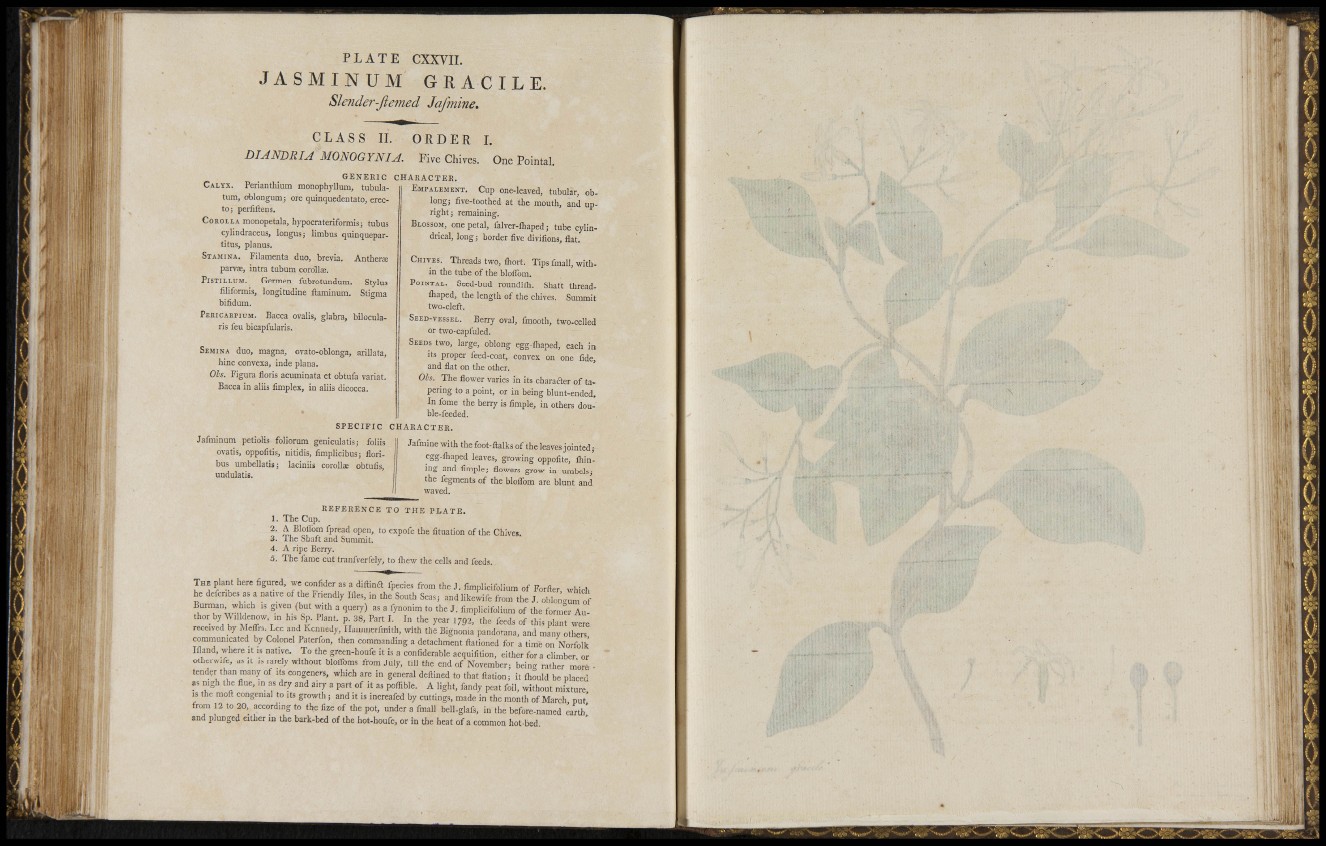
s m ji i;
m mivi
mtfl
S t;
IMiftï.
i ' f ' l ' l ' l
P L A T E CXXVIL
J A S M I N U M GRACILE.
Slender-fi erne d Jajmine.
C L A S S IL ORDER L
DIANDRI^ MONOGYNIA. Five Chives. One Pointal.
GENERIC
CALYX. Penanthlum monophyllum, tubulatum,
oblongum; ore quinquedentato, erecto;
perfifteus.
COROLLA monopetala, hypocrateriformis; tubus
cylindraceus, longus; limbus quinquepartitus,
planus.
STA.MTNA. Filamenta duo, brevia. Antherae
parvae, intra tubum coròllae.
PisTiLLUM. Germen fubrotundum. Stylus
filiformis, longitudine flaminum. Stigma
bifidum.
PEBICAEPIUM. Eacca ovalis, glabra, bilocularis
feu bicapfularis.
SEMINA duo, magna, ovato-oblonga, arillata,
liinc convexa, inde plana.
Ols. Figura floris acuminata et obtufa variat.
Bacca in aliis iimplex, in aliis dicocca.
SPECIFIC
Jafminum petiolis foliorum geniculatis; foliis
ovatis, oppofitis, nitidis, fimplicibus; floribus
umbellatis; laciniis corollae obtufis,
uudulatis,
CHAEACTEK.
EMPALEMENT. Cup one-leaved, tubular, oblong;
five-toothed at the mouth, and upright;
remaining.
BLOSSOM, one petal, falver-iliaped ; tube cylindrical,
long; border five divifions, flat.
CHIVES. Threads two, fliort. Tips fmall, within
the tube of the blolTom.
POINTAL. Seed-bud roundiih. Shaft threadihaped,
the length of the chives. Summit
two-cleft.
SEED-VESSEL. Berry oval, fmooth, two.celled
or two-capfuled.
SEEDS two, large, oblong egg-fliaped, each in
its proper feed-coat, convex on one fide,
and flat on the otlier.
Ols. The flower varies in its charafter of tapering
to a point, or in being blunt-ended.
In fome the berry is fimple, in others double
feeded.
CHAKACTEK.
Jafmine with the foot-flalks of the leaves jointed;
egg-fliaped leaves, growing oppofite, ihining
and fimple; flowers grow in umbels;
the fegments of the bloflbm are blunt and
waved.
REFERENCE TO THE PLATE.
1. The Cup.
2. A BloHom fpread open, to expofe the fituation of the Chives.
3. Ihe Shaft and Summit.
4. A ripe Berry.
5. The fame cut tranfverfely, to fliew the cells and feeds.
THE plant here figured, we confider as a diftind fpecies from the J. fimjJicifolium of Forfter, which
he defcnbes as a native of the Fnendly Ifles, in the Soutli Seas; and likewife from the J. o b l o n ^ Z 'f
" ^-"T. ' ^ J- fi'^Pli^ifoHum of the former Author
by Willdenow m his Sp. Plant, p. 38, Part I. In the year 1792, the feeds of this plant were
received by Meffrs. Lee and Kennedy, Hammerfmith, with the Bignonia pandorana, and many others
communicated by Colonel Paterfon, then commanding a detachment ftationed for a time on Norfolk
Mand, where it is native. To the green-houfe it is a confiderable acquifition, either for a climber or
other^vlfe, as it is rarely without bloffoms from July, till the end of November; being rather mora •
tender than many of its congeners, which are in general deftined to that ftation; it ftould be placed
as nigh the fine, in as dry and airy a part of it as poifible. A light, fandy peat foil, without mixture
is the moft congenial to its growth ; and it is increafed by cuttings, made in the month of March put'
from 12 to 20, according to the fize of the pot, under a fmall bell-glafs, in the before-named earth'
and plunged either in the bark-bed of the hot-houfe, or in the heat of a common hot-bed
/
, - F '
'' : I'11311
•I!; I » sf
,1 ,,
Mh
ii«-;
» - « . ^ ^ ' ^ í S - w - ,